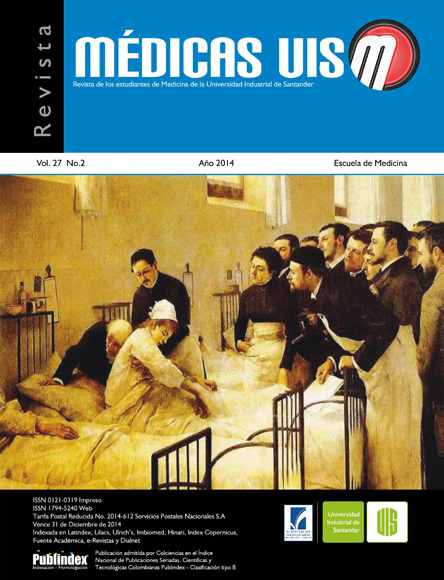Abstract
Objective: To identify the direct causes and demographic characteristics of deaths from ovarian cancer in Colombia according to data provided by death certificates. Materials and methods: Direct causes of death in women whose underlying cause of decease was ovarian malignancy as recorded by the National Department of Statistics of Colombia in 2008 were reviewed. Distribution was evaluated by the direct cause of death, age, educational level, marital status, social security and site of death. These last variables are also analyzed by age groups. Results: There were 686 deaths, aged between 13 years and 104 years, with an average age of 61,6 years [95% CI: 35.01 to 85.1]. The main direct causes of death were respiratory insufficiency or failure in 128 (18.6%), multiple organ failure in 99 (14.4%), ovarian cancer in 94 (13.7%), cardiopulmonary arrest in 82 (11.9%), septic shock or sepsis 34 (4.9%) and in 29 gross metastatic disease (4.2%). Conclusions: The main direct causes of death recorded on death certificates are non-specific or they are associated with other diseases or the underlying cause is assumed to be the direct cause of death showing errors in the correct filling out of this document in Colombia.
References
2. Liu JH, Kristine M. Zanotti K. Management of the Adnexal Mass. Obstet Gynecol.2011;117:1413–28.
3. Jelovac D, Armstrong D. Recent Progress in the Diagnosis and Treatment of Ovarian Cancer. CA Cancer J Clin.2011;61:183–203.
4. Registro poblacional de cáncer de Cali, facultad de salud Universidad del Valle [Internet]. Disponible en: rpcc.univalle.edu.co .Consultado en Julio 31, 2012.
5. Vecino A. Precisión en el diligenciamiento de los certificados de defunción en el Instituto Nacional de Cancerología, Colombia. Rev Colomb Cancerol.2006;10(3):170-82.
6. Colin D, Fat D, Inoue M, Rao C, Lopez A. Counting the death and what they died from: an assessment of the global status of death data. Bulletin of the world health organization.2005 Mar;83(3):171-7.
7. Departamento Nacional de Estadística (DANE). Resolución 0761 de 1998. Por la cual se adopta la Décima Revisión CIE-10, para codificar mortalidad. Bogotá. Colombia.
8. Agudelo B, Henao J, Méndez O. El certificado de defunción: Un instrumento para la vigilancia en salud pública [Internet]. Disponible en http://www.nacer.udea.edu.co/pdf/libros/libro1/elcertificadodedefuncion.pdf, consultado Julio 14 de 2012.
9. Secretaría Departamental de Salud. El ABC de las estadísticas vitales, Año 1 - Número 001 - Mayo 2009[Internet]. Disponible en: www.valledelcauca.gov.co/salud/descargar.php?id=1219
10. Departamento Nacional de Estadística (DANE). Registro de defunciones año 2008, Bogotá. Colombia.
11. International Classification of Diseases (ICD) [Internet]. Disponible en http://www.who.int/classifications/icd/en/. Consultado Junio 14 de 2012.
12. Kircher T, Nelson J, Burdo H. The autopsy as a measure of accuracy of the death certificate. N Engl J Med.1985;313:1263–9.
13. Cendales R, Pardo C. La calidad de certificación de la mortalidad en Colombia, 2002-2006. Rev. Salud Pública.2011;13(2):229-38.
14. Sibai A (editorial). Mortality certification and cause-of-death reporting in developing countries. Bulletin of the World Health Organization.2004 Feb;82(2):83
15. Jiménez A, Leyva R, Bacardi M. Errores en la certificación de las muertes por cáncer y limitaciones para la interpretación del sitio de origen. Salud Pública.1993;35(5):487-93.
16. RUAF-Ministerio de Salud y la Protección Social. Bogotá, Colombia [Internet]. Disponible en: http://www.minsalud.gov.co/salud/Paginas/Aplicaci%C3%B3nNacimientosyDefunciones-RUAF.aspx . Consultado Junio 14 de 2012.
17. Reade C, Elit L. Trends in Gynecologic Cancer Care in North America. Obstet Gynecol Clin N Am.2012;39:107–29.
18. Maas H, Kruitwagen R, Lemmens V, Goey S, Janssen-Heijnen M. The influence of age and co-morbidity on treatment and prognosis of ovarian cancer: a population-based study. Gynecol Oncol.2005;97(1):104 –9.
19. Petignat P, Fioretta G, Verkooijen HM, Vlastos A, Rapiti E, Bouchardy C, et al. Poorer survival of elderly patients with ovarian cancer: a population-based study. Surg Oncol.2004;13(4):181– 6.
20. Gronlund B, Hogdall C, Hansen HH, Engelholm S. Performance status rather than age is the key prognostic factor in second-line treatment of elderly patients with epithelial ovarian carcinoma. Cancer.2002;94(7):1961–7.
21. Ministerio de salud y Protección Social. Cobertura en Salud. Bogotá, Colombia. [Internet]. Disponible en: http://www.minsalud.gov.co/salud/Paginas/CoberturasdelR%C3%A9gimenSubsidiado.aspx . Consultado Junio 16 de 2012.
22. Departamento Nacional de Estadística (DANE). Bogotá, Colombia [Internet]. Disponible en: http://www.dane.gov.co/files/BoletínProyecciones.pdf. Consultado Junio 16 de 2012
23. Encuesta Nacional de Demografía y Salud 2010 – Profamilia. Bogotá, Colombia. [Internet].Disponible en: http://www.profamilia.org.co/encuestas/Profamilia/Profamilia/images/stories/PDF-capitulos/capitulo-2.pdf . Consultado en junio 16 de 2012.
24. Ochoa FL, Montoya LP. Mortalidad por cáncer en Colombia 2001. Revista CES Medicina.2004;18(2):19-36
